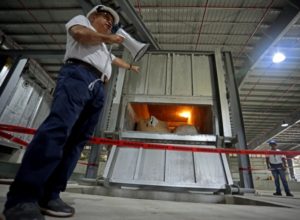A PH’s 1st stands in Lapu-Lapu lot

Compacted waste will be burned inside one of the three gasification chambers of the facility.
CDN PHOTO/LITO TECSON
Country’s first waste-to-energy facility to open in June at Barangay Basak
In three month’s time, a 1.3 hectare property in Barangay Basak in Lapu-Lapu City will become the Philippines’ first waste-to-energy facility.
Canadian firm, Aquilini Mactan Renewable Energy, Inc. (AMREI), is targeting a June opening of its facility, which uses the thermal oxidation process system (TOPS) technology.
AMREI’s plant is inside the Cebu Light Industrial Park (CLIP) at Barangay Basak, Lapu-Lapu City.
During a site visit and briefing of the facility on Saturday, AMREI President Jesus Jayme Jr. said they invested about US$ 20 million for the project.
“This facility is expected to generate around 3 megawatts (MW) of power. Of this, 1 MW will be used by the plant while the 2 MW will be sold to the locators, whoever wants to buy our power,” he said.
Apart from the electricity that will be produced by the plant, it is also expected to generate steam, hot water, and chilled water which they also plan on selling to other locators inside the CLIP.
Jayme said chilled water is especially needed by their neighboring locators for air conditioning since most of them are involved in the manufacturing of semiconductors which require a lot of this.
Process
The facility can accommodate up to 75 tons of municipal and industrial waste for it to process daily.
Garbage trucks will be dumping waste inside the facility where it will be compacted and loaded into one of three primary gasification chambers wherein the waste will be subjected to heat with a maintained temperature of 500 degrees Celsius.
“During the heating process around 90 percent of the waste are reduced to sanitized ash which can be used for the production of cement. At the same time, the temperature also makes sure that recyclables like glass bottles and metals are not harmed and can still be used,” Jayme explained.
The carbon from the heated waste will then be led into a bigger secondary oxidation chamber. There, it is subjected to a higher heat of 1,800 degrees Celsius to produce steam which is directed to the boiler system to power turbines and generate electricity.
Throughout this process, the air is already initially filtered.
But after the entire process, it will still go through a state-of-the-art air pollution control system.
“It doesn’t just meet all provincial, national and international emissions standards, it beats them by 50 to 500 times what regulators demand,” Jayme said of their filtering system.
He said they would almost have zero waste during the entire process.
He explained that by-products from the process include sanitized ash from the burning of the compacted waste, which could be sold to cement manufacturing companies which provide livelihood to nearby communities.
Aside from the ash, the other by-products from the gasification process are glass, bottles, and steel that would not be burned down in the process, and these would be sold or recycled, he said.
Jayme said that TOPS is a technology developed by AMREI together with EnEco Pacific Inc. and had been available since the late 90s.
But it took long for them to gather all the permits and certifications they needed to put the technology in place, he said.
It was in December 2010 when AMREI got into talks with officials from the Mactan Export Processing Zone (MEPZ) to develop the facility in Cebu.
Jayme also said that other countries that use the technology are Taiwan, South Korea, Malaysia and China.
He said among these countries, only China is using the technology to produce energy with its waste-to-energy facility capable of processing 300 tons of waste to generate 5 MW of power.
He said Taiwan, South Korea, Malaysia and even the US Navy are using the technology for waste destruction.
Exclusive
For now, AMREI is only allowed to accept waste from locators of all economic zones within Central Visayas which would have to pay a certain tipping fee in order to have their waste processed.
For the past five months, Jayme said they have already started receiving hazardous waste from some locators at the CLIP.
They expect to already power one of their three primary gasification chambers by next month to start processing the waste they have now inside their facility. There are a total of three primary gasification chambers in the facility with a capacity of 25 tons each.
Aside from Cebu, AMREI is also set to break ground for a similar but bigger facility in Calabarzon which will be able to process waste of up to 150 tons a day from 12 economic zones in the region. It is expected to generate 6 MW of power.
Jayme said they have already identified a three-hectare property in Batangas and target to have a groundbreaking for the facility on November 2018.
At the same time, the company is also considering to make their technology available for local government units.
In fact, they are one of several firms that have presented to the Cebu City government a proposal for a waste-to-energy facility at the defunct Inayawan landfill.
Disclaimer: The comments uploaded on this site do not necessarily represent or reflect the views of management and owner of Cebudailynews. We reserve the right to exclude comments that we deem to be inconsistent with our editorial standards.
